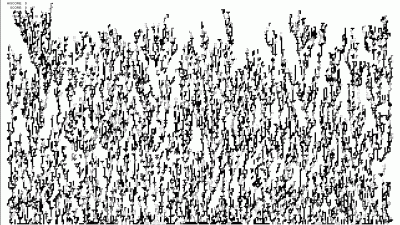
This is an illustration of randomness in a game of Tetris in a very large scale. The game ran for more than 36 hours with no more than 5 minutes of pause and less than 10 minutes of interaction interfearing with the pattern. At first it might appear a bit boring, not more than the collected works of a gang of flies shitting, but once we let ourselves inspect it there is something that could be called beauty to be found.
Is its randomness flawed? Yes, partially, not in the fact that the the pieces is not evenly spread out, but in that the outer regions are completely free. But sure, all is possible, it is just a matter of probability and the probabilty for this to happen seems to be somewhat equal to the keyboard I’m using right now to suddenly appear underneath my table due to the wave aspects of matter.
Assuming that randomness is real inside of these regions there are some neat patterns that can be found in this growth of pieces. Take a look to the right; the first and widest gap to be found from the right continues in a thin, leaning hallway almost all the way to the bottom. At the end a few pillars have emerged and a small mountain to the left which was to deliver the Game Over.
It is sometimes said that if 1 million monkeys were put to type randomly at a typewriter with time one monkey would end up with Hamlet. Or as the more nerdy version goes: If 1 million monkeys were put to programming on a computer they would given enough time end up with Windows. This has of course led some to state that time is so abundant in the universe that every thing that can happen in the universe has happened. I’m sorry copyright-people, you just don’t have a case. If that was our assumption, which is not as farfetched as it first might appear, the world would of imaterial rights would be another one.
In fact, as this final sentence is typed there might be another one out there typing exactly the same thing. Everything is possible and is happening in the infinite world.

